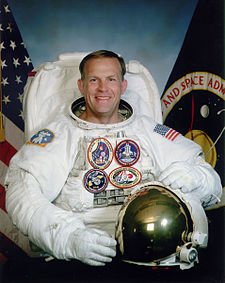Mark Charles Lee
| Mark Charles Lee | |
|---|---|
 Mark Charles Lee | |
| Astronaut NASA | |
| Státní příslušnost | |
| Datum narození | 14. srpna 1952 (70 let) |
| Místo narození | Viroqua, Wisconsin |
| Předchozí zaměstnání | vojenský pilot |
| Čas ve vesmíru | 32 dní, 21 hodin a 46 minut |
| Kosmonaut od | 1984 |
| Mise | STS-30, STS-47, STS-64, STS-82 |
| Znaky misí | |
| Kosmonaut do | 2001 |
| Pozdější zaměstnání | důchodce |
| Některá data mohou pocházet z datové položky. | |
Mark Charles Lee (* 14. srpna 1952 Viroqua, Wisconsin) je americký vojenský letec a kosmonaut. Ve vesmíru byl čtyřikrát.
Život
Studium a zaměstnání
V rodném městě absolvoval střední školu (High School, Virogua). Potom nastoupil do letecké akademie v Colorado Springs, kterou zdárně ukončil roku 1974. Studoval na Massachusetts Institute of Technology, zde ukončil studium v roce 1980.
V roce 1984 nastoupil k NASA, kde zůstal až do roku 2001. Pak pracoval v soukromém sektoru.
Oženil se dvakrát a má tři děti.
Lety do vesmíru
Na oběžnou dráhu se v raketoplánech čtyřikrát a strávil ve vesmíru 32 dní, 21 hodin a 48 minut. Třikrát vystoupil do volného vesmíru (EVA), strávil v něm 19 hodin. Byl 215. člověkem ve vesmíru.
- STS-30 Atlantis (4. května 1989 – 8. května 1989), specialista
- STS-47 Endeavour (12. září 1992 – 20. září 1992), velitel užitečného zařízení
- STS-64 Discovery (9. září 1994 – 20. září 1994), letový specialista
- STS-82 Discovery (11. února 1997 – 21. února 1997), letový specialista
Odkazy
Externí odkazy
 Obrázky, zvuky či videa k tématu Mark Charles Lee na Wikimedia Commons
Obrázky, zvuky či videa k tématu Mark Charles Lee na Wikimedia Commons - Web Space
- Web MEK.Kosmo
Média použitá na této stránce
STS-64 Mission Insignia
NASA Astronaut, Mark Charles Lee
STS-82 Mission Insignia
- STS-82 is the second mission to service the Hubble Space Telescope (HST). The central feature of the patch is HST as the crew members will see it through Discovery's overhead windows when the orbiter approaches for rendezvous, retrieval and a subsequent series of spacewalks to perform servicing tasks. The telescope is pointing toward deep space, observing the cosmos. The spiral galaxy symbolizes one of HST's important scientific missions, to accurately determine the cosmic distance scale. To the right of the telescope is a cross-like structure known as a gravitational lens, one of the numerous fundamental discoveries made using HST Imagery. The names of the STS-82 crew members are arranged around the perimeter of the patch with the extravehicular activity's (EVA) participating crew members placed in the upper semicircle and the orbiter crew in the lower one.
The STS-30 patch depicts the joining of NASA's manned and unmanned space programs. The sun and inner planets of our solar system are shown with the curve connecting Earth and Venus symbolizing the shuttle orbit, the spacecraft trajectory toward Venus, and its subsequent orbit around our sister planet. A Spanish caravel similar to the ship on the official Magellan program logo commemorates the 16th century explorer's journey and his legacy of adventure and discovery. Seven stars on the patch honor the crew of Challenger. The five-star cluster in the shape of the constellation Cassiopeia represent the five STS-30 crewmembers - Astronauts David Walker, Ronald Grabe, Norman Thagard, Mary Cleave and Mark Lee - who collectively designed the patch.
The mission emblem of STS-47 depicts the Space Shuttle Orbiter with the Spacelab module in the cargo bay against a backdrop of the flags of the United States and Japan, symbolizing the side-by-side cooperation of the two nations in this mission. The land masses of Japan and Alaska are represented on the emblem emphasizing the multi-national aspect of the flight as well as the high inclination orbit of 57 degrees. The initials `SLJ' on the left border of the emblem stand for Spacelab Japan, but the name generally used for the mission is `Spacelab-J.' The Japanese characters on the right border form the word `Fuwatto' which is the Japanese word for weightlessness.





